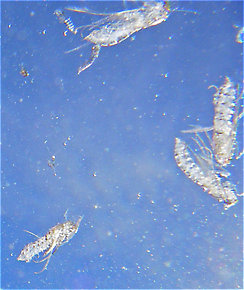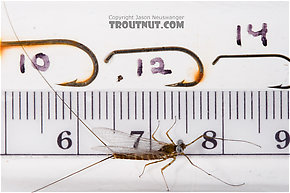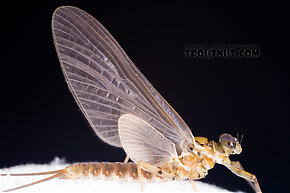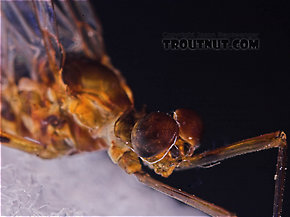Blog & Latest Updates
Fly Fishing Articles
Insects by Common Name


Mayfly Species Epeorus pleuralis (Quill Gordon)
Taxonomic Navigation -?-
Kingdom
Animalia (Animals)
» Phylum
Arthropoda (Arthropods)
» Class
Insecta (Insects)
» Order
Ephemeroptera (Mayflies)
» Genus
Epeorus (Little Maryatts)
» Species pleuralis (Quill Gordon)
Common Names
Where & When
The Quill Gordon hatch begins in early April in central Appalachian streams and moves into southern Pennsylvania by mid-April. By early May it is going strong in the Catskills, and it lingers through the rest of May in the Adirondacks and New England.
Some books report that this species occurs in the East and the Midwest, though I have not found any accounts of fishable hatches in the Midwest and they are not reported there by the USGS.
Once the pleuralis hatch is triggered by several consecutive days of ideal water temperature, it carries a sort of momentum. The duns supposedly continue to hatch almost every day, regardless of weather, until they are all done.
Hatching Behavior
Time Of Day (?): Early afternoon, usually from 1:00 to 2:00pm; later when hot
Habitat: Riffles and rapids
Water Temperature: 48-53°F
Quill Gordon duns crawl out of their nymphal shucks (Habitat: Riffles and rapids
Water Temperature: 48-53°F

Here's an underwater view of the pupal shucks of several already-emerged Brachycentrus numerosus caddisflies.
It is best fished by casting upstream, allowing it to sink, and then twitching it up through the currents in front of feeding fish.
Once the duns are up, they may ride the surface for a long time and make several failed attempts before getting airborne. Skittering a dry fly accordingly may improve one's success.
Spinner Behavior
Time Of Day: Anytime between noon and dusk, depending on temperature
Habitat: Riffles and rapids
There are several values given in the fly fishing literature for the time it takes Epeorus pleuralis duns to molt and return as spinners. Different books say 1-2 days, 2 days, or 3-4 days. Habitat: Riffles and rapids
These spinners can provide good fishing, especially in pocket water in the rapids where they fall spent (Spent: The wing position of many aquatic insects when they fall on the water after mating. The wings of both sides lay flat on the water. The word may be used to describe insects with their wings in that position, as well as the position itself.).
Nymph Biology
Current Speed: Fast
Substrate: Gravel or rock
Environmental Tolerance: Very intolerant of pollution or slow water
Several authors have noted that Epeorus pleuralis nymphs have an unusual habit of gathering en masse on the downstream side of certain objects in the stream prior to emergence. These objects may become a source of unexpected feeding lanes for the trout during emergence.Substrate: Gravel or rock
Environmental Tolerance: Very intolerant of pollution or slow water
Epeorus pleuralis Fly Fishing Tips
In the cold water of the early season when the Quill Gordons hatch, the trout may not yet rise freely. Although this hatch can provide good dry fly action, you should not hesitate to fish subsurface.
Pictures of 5 Mayfly Specimens in the Species Epeorus pleuralis:
Male Epeorus pleuralis (Quill Gordon) Mayfly Spinner View 10 PicturesA few days earlier I photographed this same specimen as a dun. The changes between dun and spinner seem particularly dramatic in this species.
View 10 PicturesA few days earlier I photographed this same specimen as a dun. The changes between dun and spinner seem particularly dramatic in this species.
 View 10 PicturesA few days earlier I photographed this same specimen as a dun. The changes between dun and spinner seem particularly dramatic in this species.
View 10 PicturesA few days earlier I photographed this same specimen as a dun. The changes between dun and spinner seem particularly dramatic in this species.Collected April 30, 2007 from Dresserville Creek in New York
Added to Troutnut.com by Troutnut on May 3, 2007
Added to Troutnut.com by Troutnut on May 3, 2007
Male Epeorus pleuralis (Quill Gordon) Mayfly Dun View 9 PicturesI kept this specimen after photographing it and it molted into a spinner in perfect condition, which I photographed here.
View 9 PicturesI kept this specimen after photographing it and it molted into a spinner in perfect condition, which I photographed here.
 View 9 PicturesI kept this specimen after photographing it and it molted into a spinner in perfect condition, which I photographed here.
View 9 PicturesI kept this specimen after photographing it and it molted into a spinner in perfect condition, which I photographed here.Collected April 30, 2007 from Dresserville Creek in New York
Added to Troutnut.com by Troutnut on May 3, 2007
Added to Troutnut.com by Troutnut on May 3, 2007
Male Epeorus pleuralis (Quill Gordon) Mayfly Spinner View 10 PicturesI spent (Spent: The wing position of many aquatic insects when they fall on the water after mating. The wings of both sides lay flat on the water. The word may be used to describe insects with their wings in that position, as well as the position itself.) most of the day looking for Epeorus pluralis duns or spinners without any luck on the major Catskill rivers. Finally in the evening I arrived at a small stream somebody had recommended, and when I got out of the car I was happy to find that I had parked in the middle of a cloud of male spinners.
View 10 PicturesI spent (Spent: The wing position of many aquatic insects when they fall on the water after mating. The wings of both sides lay flat on the water. The word may be used to describe insects with their wings in that position, as well as the position itself.) most of the day looking for Epeorus pluralis duns or spinners without any luck on the major Catskill rivers. Finally in the evening I arrived at a small stream somebody had recommended, and when I got out of the car I was happy to find that I had parked in the middle of a cloud of male spinners.
 View 10 PicturesI spent (Spent: The wing position of many aquatic insects when they fall on the water after mating. The wings of both sides lay flat on the water. The word may be used to describe insects with their wings in that position, as well as the position itself.) most of the day looking for Epeorus pluralis duns or spinners without any luck on the major Catskill rivers. Finally in the evening I arrived at a small stream somebody had recommended, and when I got out of the car I was happy to find that I had parked in the middle of a cloud of male spinners.
View 10 PicturesI spent (Spent: The wing position of many aquatic insects when they fall on the water after mating. The wings of both sides lay flat on the water. The word may be used to describe insects with their wings in that position, as well as the position itself.) most of the day looking for Epeorus pluralis duns or spinners without any luck on the major Catskill rivers. Finally in the evening I arrived at a small stream somebody had recommended, and when I got out of the car I was happy to find that I had parked in the middle of a cloud of male spinners.Collected April 19, 2006 from Mongaup Creek in New York
Added to Troutnut.com by Troutnut on April 22, 2006
Added to Troutnut.com by Troutnut on April 22, 2006
Your Thoughts On Epeorus pleuralis:
Top 10 Fly Hatches
Top Gift Shop Designs
Eat mayflies.
Top Insect Specimens
Miscellaneous Sites
Troutnut.com is copyright © 2004-2024 Jason
Neuswanger (email Jason). See my FAQ for information about use of my images.
 privacy policy
privacy policy
